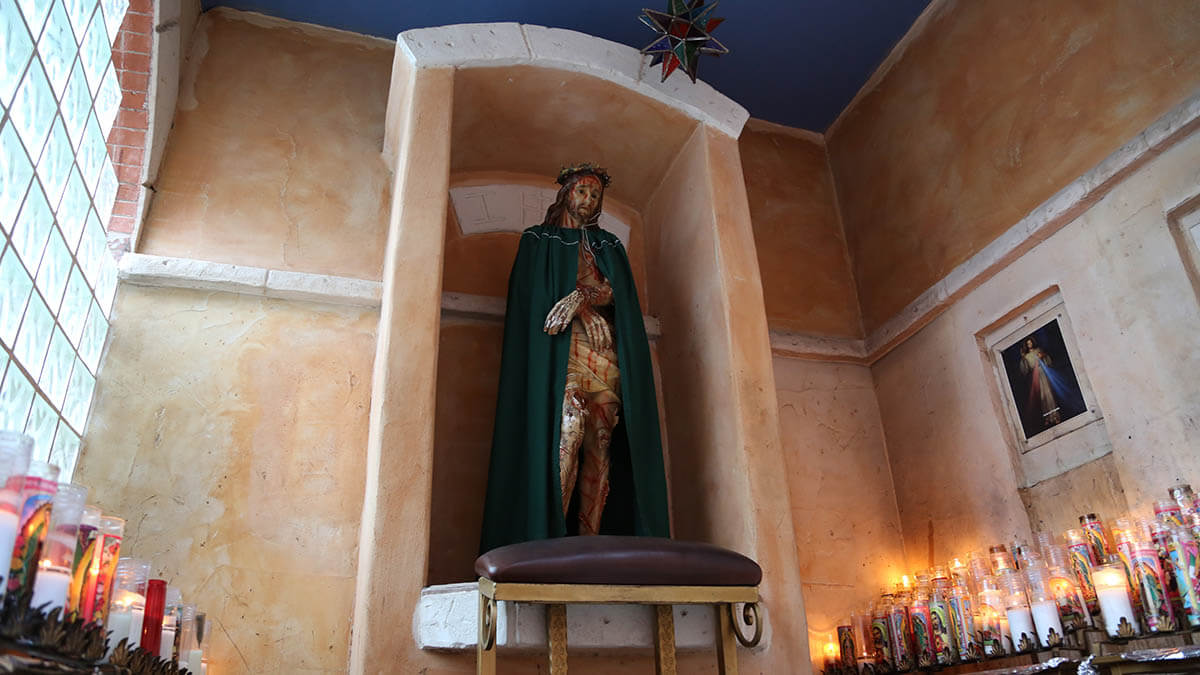
A visiting Jesuit priest gives his take on the biggest problem his congregation in the west side faces.
Faces of San Antonio is an occasional series at Folo Media.

After two years at Our Lady of Guadalupe Church and Shrine, Father Bryan Christopher is leaving for Central America. Photo by the H. E. Butt Foundation.
The statue of a gory, bloodied and crucified Jesus Christ, surrounded by more than 30 prayer candles and a Holy Water dispenser, is a popular place for residents of this West Side neighborhood day and night.
The shrine is located on the campus of Our Lady of Guadalupe Church and Shrine on El Paso Street.
About three times a week, one woman will come to the statue and sing. Others sob or yell as they kneel down on a brown leather stool.
For two years, Father Bryan Christopher, a visiting Jesuit priest, slept in a room right above the statue.
Christopher came to Our Lady of Guadalupe from a parish in one of the poorest and most violent parts of Belize. On Sunday, he concluded his two-year stay in San Antonio and is leaving to visit family before he heads back to Central America.
When asked what he thought the biggest struggle on the West Side was, Christopher didn’t say poverty, education or stagnation — like someone who knows San Antonio might expect.
Instead, he said trauma.
“I think these people feel connected to the statue because they know that their Jesus is a figure who suffered trauma like they have,” Christopher said.
The parish was formed in 1911. At that time, Mexican immigrants were essentially forced into the area, Christopher claims. The neighborhood was the lowest part of San Antonio and often flooded, bringing destruction and sadness in its wake.
Trauma “can also be caused by poverty — just you not knowing where your next meal is going to come from and then living in such precarious situations day after day,” Christopher said. “That can cause the same kind of trauma. . . . A lot of people just live hand to mouth. I don’t know how a lot of our neighbors live. It’s hard to do things like hold a regular job when there’s so much chaos in your life. It’s really hard.”
Christopher, originally from a stable neighborhood in St. Louis, says that if he could do these two years over again, he would try to get more involved and get to know the community through simple gestures like waving “Hi” when crossing the street.

In 1911, Our Lady of Guadalupe Church on El Paso Street was established. Photo by the H. E. Butt Foundation.
“Being a white male, I want to fix things and I can’t,” Christopher said. “The challenge is: How do you accompany people? It’s not always easy to form relationships. I think it takes a lot of time, because it needs trust. I think people look at me, and if they don’t know that I’m a priest — even if they do know I’m a priest — I look like a cop.”
Christopher also struggles to find the right approach to bring up the subject when preaching, he said.
Christian churches “don’t think about trauma,” Christopher said. “It brings a lot of interesting questions to the Scriptures itself.
“For instance, how do you on Easter Sunday proclaim the resurrection and Jesus’ victory over death, and there’s no longer anything to be scared of because Jesus has conquered all that? How do you proclaim that in a neighborhood where people do have a lot of things to be afraid of and where every day is a struggle?”
This article was originally published by the H.E. Butt Foundation’s Folo Media initiative in 2017.